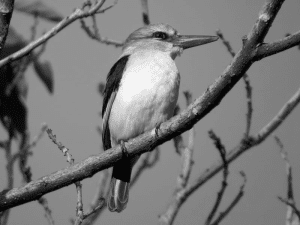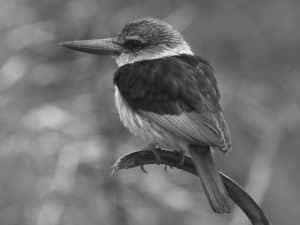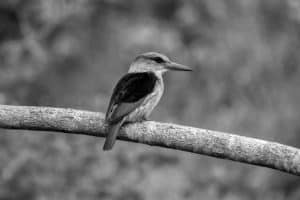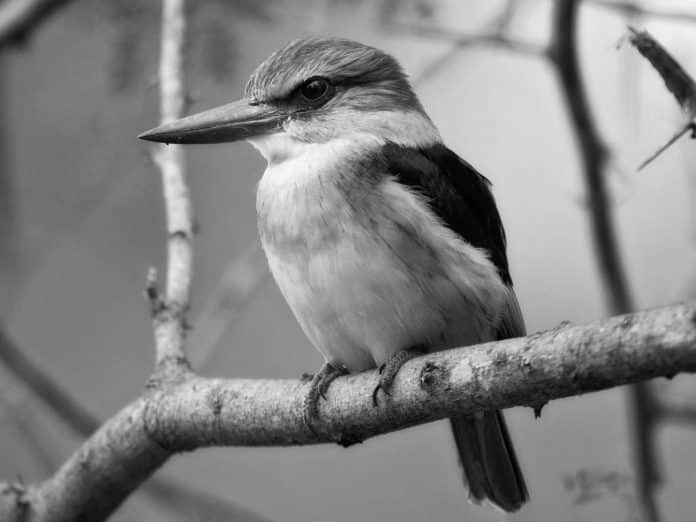Introduction to the Brown-Hooded Kingfisher
Welcome to the enchanting world of the Brown-Hooded Kingfisher, a stunning avian species that graces the woodlands of Tanzania with its earth-toned elegance. The Brown-Hooded Kingfisher in Tanzania, scientifically known as Halcyon albiventris, is a member of the kingfisher family and is renowned for its striking appearance and mesmerizing calls. This captivating bird is a true gem of Tanzania’s avifauna, captivating birdwatchers and nature enthusiasts with its beauty and charm.

The Brown-Hooded Kingfisher is a medium-sized bird, measuring around 20 centimeters in length, with a distinct brown head and back, a white throat and collar, and a vibrant turquoise-blue rump and tail. Its long, sharp beak and keen eyes make it a formidable hunter, specializing in catching insects, small reptiles, and even fish. The melodious calls of the Brown-Hooded Kingfisher resonate through the woodlands, adding a symphonic touch to the natural ambiance of Tanzania.
Habitat and Distribution of the Brown-Hooded Kingfisher in Tanzania
The Brown-Hooded Kingfisher is primarily found in the woodland and riverine habitats of Tanzania, favoring areas with dense vegetation, open woodlands, and proximity to water sources such as rivers, streams, and marshes. This species is distributed across various regions of Tanzania, including the eastern and southern parts of the country, where it can be spotted perched on branches, scanning for prey or engaging in its characteristic diving and swooping behaviors.
The woodlands and savannas of Tanzania provide the perfect backdrop for the Brown-Hooded Kingfisher’s activities, offering a rich tapestry of flora and fauna for it to thrive in. From the coastal areas to the inland plains, this beautiful bird has carved out its niche in the diverse landscapes of Tanzania, showcasing its adaptability and resilience in the face of changing environmental conditions.
Physical Characteristics and Behavior of the Brown-Hooded Kingfisher
The Brown-Hooded Kingfisher is adorned with a stunning array of physical attributes that set it apart as a truly remarkable species. Its earth-toned plumage, with shades of brown, white, and turquoise, provides excellent camouflage amidst the foliage, allowing it to blend seamlessly into its natural surroundings. The keen eyesight and lightning-fast reflexes of the Brown-Hooded Kingfisher make it a formidable predator, capable of swiftly capturing its prey with precision and agility.
In addition to its hunting prowess, the Brown-Hooded Kingfisher is known for its fascinating behaviors, such as its distinctive calls, aerial acrobatics, and elaborate courtship displays. During the breeding season, these birds engage in intricate rituals, including vibrant plumage displays and duets of melodious calls, creating a spectacle that is a testament to the wonders of nature.
Conservation Status of the Brown-Hooded Kingfisher in Tanzania
The conservation status of the Brown-Hooded Kingfisher in Tanzania is a subject of paramount importance, as the species faces various threats stemming from habitat loss, deforestation, and human activities. Despite being a relatively common sight in certain regions of Tanzania, the Brown-Hooded Kingfisher’s habitats are increasingly under pressure from agricultural expansion, logging, and urban development, leading to concerns about the long-term viability of its populations.
Efforts to safeguard the woodlands and waterways that the Brown-Hooded Kingfisher relies on are crucial for ensuring the species’ continued survival in Tanzania. Conservation initiatives, habitat restoration projects, and community engagement are essential components of protecting the habitats that are vital to the well-being of the Brown-Hooded Kingfisher and other wildlife in Tanzania.
Best Places for Birdwatching the Brown-Hooded Kingfisher in Tanzania

Tanzania is blessed with an abundance of natural wonders, and there are several prime locations where birdwatchers can delight in the sights and sounds of the Brown-Hooded Kingfisher. The woodlands and riverine areas of national parks such as the Selous Game Reserve, Ruaha National Park, and Mikumi National Park offer excellent opportunities to observe and photograph these magnificent birds in their natural habitats.
The rich biodiversity and scenic landscapes of these protected areas provide an ideal setting for birdwatching, with the Brown-Hooded Kingfisher often making appearances near water bodies and along the fringes of the woodlands. Whether you are an avid birdwatcher or a nature enthusiast, these renowned national parks in Tanzania promise unforgettable encounters with the Brown-Hooded Kingfisher and a myriad of other avian species.
Photography Tips for Capturing the Brown-Hooded Kingfisher
Capturing the beauty and elegance of the Brown-Hooded Kingfisher through photography is a rewarding endeavor that requires patience, skill, and a keen eye for detail. When seeking to photograph these elusive birds in Tanzania, it is essential to approach their habitats with care and respect for their natural behaviors. Utilizing camouflage, telephoto lenses, and a good understanding of lighting and composition can greatly enhance the quality of your bird photography.
The early morning and late afternoon hours are prime times for photographing the Brown-Hooded Kingfisher, as the soft, golden light enhances the colors of their plumage and creates captivating visual effects. By positioning yourself strategically near their favored perches and observing their movements, you can increase your chances of capturing stunning images that showcase the grace and allure of these remarkable birds.
Interesting Facts and Folklore about the Brown-Hooded Kingfisher
The Brown-Hooded Kingfisher has long been associated with folklore and symbolism in various cultures across Africa. In Tanzanian folklore, the kingfisher is often revered as a symbol of peace, prosperity, and good fortune, with its vibrant colors and graceful presence inspiring stories and legends that celebrate its significance in the natural world. Additionally, the distinctive calls of the Brown-Hooded Kingfisher have been woven into the fabric of local traditions, adding a touch of mystique to its portrayal in indigenous narratives.
Beyond folklore, the Brown-Hooded Kingfisher also holds a wealth of fascinating biological facts that intrigue researchers and enthusiasts alike. From its specialized hunting techniques to its migratory patterns, the life history of the Brown-Hooded Kingfisher is a testament to the intricacies of avian biology and the marvels of evolution. Exploring these facts and folklore adds an enriching dimension to the appreciation of this remarkable species.
The Role of Brown-Hooded Kingfishers in Tanzanian Ecosystems
As integral members of the Tanzanian ecosystems, Brown-Hooded Kingfishers play a vital role in maintaining ecological balance and contributing to the dynamics of their habitats. By regulating insect populations, preying on small vertebrates, and participating in nutrient cycling through their foraging activities, these birds exert influence on the interconnected web of life in the woodlands and riverine environments they inhabit.
Furthermore, the presence of Brown-Hooded Kingfishers serves as an indicator of the health and vitality of the ecosystems they inhabit, reflecting the quality of habitats and the availability of resources. Their interactions with other species, including potential competitors and predators, contribute to the intricate tapestry of relationships that shape the natural landscapes of Tanzania.
Birdwatching Tours and Guides for Observing the Brown-Hooded Kingfisher in Tanzania

For those seeking immersive experiences in observing the Brown-Hooded Kingfisher and other avian treasures of Tanzania, birdwatching tours and expert guides offer invaluable opportunities to explore the country’s diverse habitats and encounter its rich birdlife. Professional birdwatching tours provide access to prime birding locations, knowledgeable guides, and specialized equipment, ensuring that enthusiasts can maximize their chances of encountering the Brown-Hooded Kingfisher and a myriad of other avian species.
Whether you are a seasoned birder or a novice nature enthusiast, the guidance and expertise of experienced birdwatching guides can enrich your journey, providing insights into the behaviors, ecology, and conservation of the species you encounter. By participating in birdwatching tours and engaging with local guides, you can gain a deeper understanding of Tanzania’s avian diversity and contribute to the conservation efforts that safeguard its natural heritage.
Conclusion
In conclusion, the Brown-Hooded Kingfisher embodies the earth-toned elegance and natural allure of Tanzania’s woodlands, captivating the hearts and imaginations of all who have the privilege of encountering it. From its striking appearance and enchanting calls to its ecological significance and cultural resonance, this remarkable bird symbolizes the splendor of Tanzania’s avifauna and the importance of preserving its habitats for future generations to cherish.
As you embark on your exploration of Tanzania’s natural wonders, may the presence of the Brown-Hooded Kingfisher serve as a reminder of the intricate beauty and interconnectedness of the natural world, inspiring a deep appreciation for the rich tapestry of life that thrives in the woodlands and riverine landscapes of this remarkable country.


































